Nepafenac-Loaded Cyclodextrin/Polymer Nanoaggregates: A New Approach to Eye Drop Formulation
Abstract
1. Introduction
2. Materials and Methods
2.1. Materials
2.2. Moisture Content of CDs
2.3. Chemical Stability of Nepafenac
2.4. Quantitative Analysis
2.5. Phase Solubility Studies
2.6. Complex Characterization in Solid State
2.6.1. Preparation of Inclusion Complexes
2.6.2. Fourier Transform Infra-Red (FT-IR) Spectroscopy
2.6.3. Differential Scanning Calorimetry (DSC)
2.7. Structure of Inclusion Complexes Combining Nepafenac with γCD and HPβCD
2.8. Influence of Water-Soluble Polymers on Solubility of Complexes and Effect of Mixtures of γCD and HPβCD
2.9. Preparation and Characterization of 0.5% (w/v) Nepafenac Eye Drops
2.9.1. Solid Drug Fraction
2.9.2. Dynamic Light Scattering
2.9.3. Physicochemical Properties
2.9.4. Transmission Electron Microscope (TEM) Analysis
3. Results and Discussion
3.1. Stability of Nepafenac in Autoclave and Sonicator
3.2. Phase-Solubility Studies
3.3. Influence of Adding Water-Soluble Polymers on the Solubility of Nepafanec/CD Complexes and Impact of Mixing γCD and HPβCD
3.4. Solid State Characterization of Nepafenac/CD Inclusion Complexes
3.4.1. FT-IR Spectra
3.4.2. DSC
3.5. Structure of Nepafenac/γCD/HPβCD Inclusion Complexes
3.6. Characterization of Formulation of 0.5% (w/v) Nepafenac Eye Drops
TEM Analysis
4. Conclusions
Supplementary Materials
Author Contributions
Funding
Conflicts of Interest
References
- Achiron, A.; Karmona, L.; Mimouni, M.; Gershoni, A.; Dzhanov, Y.; Gur, Z.; Burgansky, Z. Comparison of the Tolerability of Diclofenac and Nepafenac. J. Ocul. Pharmacol. Ther. 2016, 32, 601–605. [Google Scholar] [CrossRef] [PubMed]
- Caldwell, M.; Reilly, C. Effects of topical nepafenac on corneal epithelial healing time and postoperative pain after PRK: A bilateral, prospective, randomized, masked trial. J. Refract. Surg. 2008, 24, 377–382. [Google Scholar] [PubMed]
- Lane, S.S.; Modi, S.S.; Lehmann, R.P.; Holland, E.J. Nepafenac ophthalmic suspension 0.1% for the prevention and treatment of ocular inflammation associated with cataract surgery. J. Cataract Refract. Surg. 2007, 33, 53–58. [Google Scholar] [CrossRef] [PubMed]
- Margulis, A.V.; Houben, E.; Hallas, J.; Overbeek, J.A.; Pottegård, A.; Torp-Pedersen, T.; Perez-Gutthann, S.; Arana, A. Ophthalmic nepafenac use in the Netherlands and Denmark. Acta Ophthalmol. 2017, 95, 509–517. [Google Scholar] [CrossRef] [PubMed]
- Ikuta, Y.; Aoyagi, S.; Tanaka, Y.; Sato, K.; Inada, S.; Koseki, Y.; Onodera, T.; Oikawa, H.; Kasai, H. Creation of nano eye-drops and effective drug delivery to the interior of the eye. Sci. Rep. 2017, 7, 44229. [Google Scholar] [CrossRef] [PubMed]
- Urtti, A. Challenges and obstacles of ocular pharmacokinetics and drug delivery. Adv. Drug Deliv. Rev. 2006, 58, 1131–1135. [Google Scholar] [CrossRef] [PubMed]
- Wang, Y.; Xu, X.; Gu, Y.; Cheng, Y.; Cao, F. Recent advance of nanoparticle-based topical drug delivery to the posterior segment of the eye. Expert Opin. Drug Deliv. 2018, 15, 687–701. [Google Scholar] [CrossRef] [PubMed]
- Achouri, D.; Alhanout, K.; Piccerelle, P.; Andrieu, V. Recent advances in ocular drug delivery. Drug Dev. Ind. Pharm. 2013, 39, 1599–1617. [Google Scholar] [CrossRef] [PubMed]
- Ludwig, A. The use of mucoadhesive polymers in ocular drug delivery. Adv. Drug Deliv. Rev. 2005, 57, 1595–1639. [Google Scholar] [CrossRef] [PubMed]
- Shelley, H.; Babu, R.J. Role of Cyclodextrins in Nanoparticle-Based Drug Delivery Systems. J. Pharm. Sci. 2018, 107, 1741–1753. [Google Scholar] [CrossRef]
- Simões, S.M.N.; Rey-Rico, A.; Concheiro, A.; Alvarez-Lorenzo, C. Supramolecular cyclodextrin-based drug nanocarriers. Chem. Commun. 2015, 51, 6275–6289. [Google Scholar] [CrossRef] [PubMed]
- Varan, G.; Varan, C.; Erdogar, N.; Hincal, A.A.; Bilensoy, E. Amphiphilic cyclodextrin nanoparticles. Int. J. Pharm. 2017, 531, 457–469. [Google Scholar] [CrossRef] [PubMed]
- Moya-Ortega, M.D.; Alvarez-Lorenzo, C.; Concheiro, A.; Loftsson, T. Cyclodextrin-based nanogels for pharmaceutical and biomedical applications. Int. J. Pharm. 2012, 428, 152–163. [Google Scholar] [CrossRef]
- De Souza, V.C.; Barros, C.H.N.; Tasic, L.; Gimenez, I.F.; Teixeira Camargo, Z. Synthesis of cyclodextrin polymers containing glutamic acid and their use for the synthesis of Ag nanoparticles. Carbohydr. Polym. 2018, 202, 11–19. [Google Scholar] [CrossRef] [PubMed]
- Gidwani, B.; Vyas, A. Synthesis, characterization and application of Epichlorohydrin-β-cyclodextrin polymer. Colloids Surf. B Biointerfaces 2014, 114, 130–137. [Google Scholar] [CrossRef] [PubMed]
- Lim, L.M.; Tran, T.T.; Long Wong, J.J.; Wang, D.; Cheow, W.S.; Hadinoto, K. Amorphous ternary nanoparticle complex of curcumin-chitosan-hypromellose exhibiting built-in solubility enhancement and physical stability of curcumin. Colloids Surf. B Biointerfaces 2018, 167, 483–491. [Google Scholar] [CrossRef] [PubMed]
- Xiao, P.; Dudal, Y.; Corvini, P.F.X.; Shahgaldian, P. Polymeric cyclodextrin-based nanoparticles: Synthesis, characterization and sorption properties of three selected pharmaceutically active ingredients. Polym. Chem. 2011, 2, 120–125. [Google Scholar] [CrossRef]
- Zhou, J.; Ritter, H. Cyclodextrin functionalized polymers as drug delivery systems. Polym. Chem. 2010, 1, 1552–1559. [Google Scholar] [CrossRef]
- Sapte, S.; Pore, Y. Inclusion complexes of cefuroxime axetil with beta-cyclodextrin: Physicochemical characterization, molecular modeling and effect of l-arginine on complexation. J. Pharm. Anal. 2016, 6, 300–306. [Google Scholar] [CrossRef]
- Schwarz, D.H.; Engelke, A.; Wenz, G. Solubilizing steroidal drugs by beta-cyclodextrin derivatives. Int. J. Pharm. 2017, 531, 559–567. [Google Scholar] [CrossRef]
- Szabó, Z.I.; Deme, R.; Mucsi, Z.; Rusu, A.; Mare, A.D.; Fiser, B.; Toma, F.; Sipos, E.; Tóth, G. Equilibrium, structural and antibacterial characterization of moxifloxacin-β-cyclodextrin complex. J. Mol. Struct. 2018, 1166, 228–236. [Google Scholar] [CrossRef]
- Vaidya, B.; Parvathaneni, V.; Kulkarni, N.S.; Shukla, S.K.; Damon, J.K.; Sarode, A.; Kanabar, D.; Garcia, J.V.; Mitragotri, S.; Muth, A.; et al. Cyclodextrin modified erlotinib loaded PLGA nanoparticles for improved therapeutic efficacy against non-small cell lung cancer. Int. J. Biol. Macromol. 2019, 122, 338–347. [Google Scholar] [CrossRef]
- Vaidya, B.; Shukla, S.K.; Kolluru, S.; Huen, M.; Mulla, N.; Mehra, N.; Kanabar, D.; Palakurthi, S.; Ayehunie, S.; Muth, A.; et al. Nintedanib-cyclodextrin complex to improve bio-activity and intestinal permeability. Carbohydr. Polym. 2019, 204, 68–77. [Google Scholar] [CrossRef] [PubMed]
- Ryzhakov, A.; Do Thi, T.; Stappaerts, J.; Bertoletti, L.; Kimpe, K.; Couto, A.R.S.; Saokham, P.; Van den Mooter, G.; Augustijns, P.; Somsen, G.W.; et al. Self-Assembly of Cyclodextrins and Their Complexes in Aqueous Solutions. J. Pharm. Sci. 2016, 105, 2556–2569. [Google Scholar] [CrossRef] [PubMed]
- Gidwani, B.; Vyas, A. A Comprehensive Review on Cyclodextrin-Based Carriers for Delivery of Chemotherapeutic Cytotoxic Anticancer Drugs. BioMed Res. Int. 2015, 2015, 198268. [Google Scholar] [CrossRef] [PubMed]
- Jambhekar, S.S.; Breen, P. Cyclodextrins in pharmaceutical formulations I: Structure and physicochemical properties, formation of complexes and types of complex. Drug Discov. Today 2016, 21, 356–362. [Google Scholar] [CrossRef] [PubMed]
- Monteil, M.; Lecouvey, M.; Landy, D.; Ruellan, S.; Mallard, I. Cyclodextrins: A promising drug delivery vehicle for bisphosphonate. Carbohydr. Polym. 2017, 156, 285–293. [Google Scholar] [CrossRef] [PubMed]
- Aloisio, C.; de Oliveira, A.G.; Longhi, M. Solubility and release modulation effect of sulfamerazine ternary complexes with cyclodextrins and meglumine. J. Pharm. Biomed. Anal. 2014, 100, 64–73. [Google Scholar] [CrossRef]
- Higashi, K.; Ideura, S.; Waraya, H.; Moribe, K.; Yamamoto, K. Structural evaluation of crystalline ternary gamma-cyclodextrin complex. J. Pharm. Sci. 2011, 100, 325–333. [Google Scholar] [CrossRef]
- Inoue, Y.; Iohara, D.; Sekiya, N.; Yamamoto, M.; Ishida, H.; Sakiyama, Y.; Hirayama, F.; Arima, H.; Uekama, K. Ternary inclusion complex formation and stabilization of limaprost, a prostaglandin E1 derivative, in the presence of alpha- and beta-cyclodextrins in the solid state. Int. J. Pharm. 2016, 509, 338–347. [Google Scholar] [CrossRef]
- Mennini, N.; Maestrelli, F.; Cirri, M.; Mura, P. Analysis of physicochemical properties of ternary systems of oxaprozin with randomly methylated-ss-cyclodextrin and l-arginine aimed to improve the drug solubility. J. Pharm. Biomed. Anal. 2016, 129, 350–358. [Google Scholar] [CrossRef] [PubMed]
- Palma, S.D.; Tartara, L.I.; Quinteros, D.; Allemandi, D.A.; Longhi, M.R.; Granero, G.E. An efficient ternary complex of acetazolamide with HP-ß-CD and TEA for topical ocular administration. J. Control. Release 2009, 138, 24–31. [Google Scholar] [CrossRef]
- Wang, D.; Li, H.; Gu, J.; Guo, T.; Yang, S.; Guo, Z.; Zhang, X.; Zhu, W.; Zhang, J. Ternary system of dihydroartemisinin with hydroxypropyl-beta-cyclodextrin and lecithin: Simultaneous enhancement of drug solubility and stability in aqueous solutions. J. Pharm. Biomed. Anal. 2013, 83, 141–148. [Google Scholar] [CrossRef] [PubMed]
- Terekhova, I.; Chibunova, E.; Kumeev, R.; Kruchinin, S.; Fedotova, M.; Kozbiał, M.; Wszelaka-Rylik, M.; Gierycz, P. Specific and nonspecific effects of biologically active inorganic salts on inclusion complex formation of cyclodextrins with aromatic carboxylic acids. Chem. Eng. Sci. 2015, 122, 97–103. [Google Scholar] [CrossRef]
- De Medeiros, A.S.; Zoppi, A.; Barbosa, E.G.; Oliveira, J.I.; Fernandes-Pedrosa, M.F.; Longhi, M.R.; da Silva-Júnior, A.A. Supramolecular aggregates of oligosaccharides with co-solvents in ternary systems for the solubilizing approach of triamcinolone. Carbohydr. Polym. 2016, 151, 1040–1051. [Google Scholar] [CrossRef]
- Jadhav, P.; Petkar, B.; Pore, Y.; Kulkarni, A.; Burade, K. Physicochemical and molecular modeling studies of cefixime–l-arginine–cyclodextrin ternary inclusion compounds. Carbohydr. Polym. 2013, 98, 1317–1325. [Google Scholar]
- Bera, H.; Chekuri, S.; Sarkar, S.; Kumar, S.; Muvva, N.B.; Mothe, S.; Nadimpalli, J. Novel pimozide-β-cyclodextrin-polyvinylpyrrolidone inclusion complexes for Tourette syndrome treatment. J. Mol. Liq. 2016, 215, 135–143. [Google Scholar] [CrossRef]
- Davis, M.T.; Potter, C.B.; Mohammadpour, M.; Albadarin, A.B.; Walker, G.M. Design of spray dried ternary solid dispersions comprising itraconazole, soluplus and HPMCP: Effect of constituent compositions. Int. J. Pharm. 2017, 519, 365–372. [Google Scholar] [CrossRef]
- Patel, P.; Agrawal, Y.K.; Sarvaiya, J. Cyclodextrin based ternary system of modafinil: Effect of trimethyl chitosan and polyvinylpyrrolidone as complexing agents. Int. J. Biol. Macromol. 2016, 84, 182–188. [Google Scholar] [CrossRef]
- Soliman, K.A.; Ibrahim, H.K.; Ghorab, M.M. Effect of different polymers on avanafil-beta-cyclodextrin inclusion complex: In vitro and in vivo evaluation. Int. J. Pharm. 2016, 512, 168–177. [Google Scholar] [CrossRef]
- Nogueiras-Nieto, L.; Sobarzo-Sanchez, E.; Gomez-Amoza, J.L.; Otero-Espinar, F.J. Competitive displacement of drugs from cyclodextrin inclusion complex by polypseudorotaxane formation with poloxamer: Implications in drug solubilization and delivery. Eur. J. Pharm. Biopharm. 2012, 80, 585–595. [Google Scholar] [CrossRef]
- Taveira, S.F.; Varela-Garcia, A.; dos Santos Souza, B.; Marreto, R.N.; Martin-Pastor, M.; Concheiro, A.; Alvarez-Lorenzo, C. Cyclodextrin-based poly(pseudo)rotaxanes for transdermal delivery of carvedilol. Carbohydr. Polym. 2018, 200, 278–288. [Google Scholar] [CrossRef]
- Jansook, P.; Muankaew, C.; Stefansson, E.; Loftsson, T. Development of eye drops containing antihypertensive drugs: Formulation of aqueous irbesartan/γCD eye drops. Pharm. Dev. Technol. 2015, 20, 626–632. [Google Scholar] [CrossRef]
- Jansook, P.; Pichayakorn, W.; Muankaew, C.; Loftsson, T. Cyclodextrin-poloxamer aggregates as nanocarriers in eye drop formulations: Dexamethasone and amphotericin B. Drug Dev. Ind. Pharm. 2016, 42, 1446–1454. [Google Scholar] [CrossRef]
- Johannsdottir, S.; Jansook, P.; Stefansson, E.; Loftsson, T. Development of a cyclodextrin-based aqueous cyclosporin A eye drop formulations. Int. J. Pharm. 2015, 493, 86–95. [Google Scholar] [CrossRef]
- Muankaew, C.; Jansook, P.; Sigurdsson, H.H.; Loftsson, T. Cyclodextrin-based telmisartan ophthalmic suspension: Formulation development for water-insoluble drugs. Int. J. Pharm. 2016, 507, 21–31. [Google Scholar] [CrossRef] [PubMed]
- Loftsson, T.; Brewster, M.E. Cyclodextrins as functional excipients: Methods to enhance complexation efficiency. J. Pharm. Sci. 2012, 101, 3019–3032. [Google Scholar] [CrossRef]
- Ogawa, N.; Furuishi, T.; Nagase, H.; Endo, T.; Takahashi, C.; Yamamoto, H.; Kawashima, Y.; Loftsson, T.; Kobayashi, M.; Ueda, H. Interaction of fentanyl with various cyclodextrins in aqueous solutions. J. Pharm. Pharm. 2016, 68, 588–597. [Google Scholar] [CrossRef]
- Jansook, P.; Kurkov, S.V.; Loftsson, T. Cyclodextrins as solubilizers: Formation of complex aggregates. J. Pharma. Sci. 2010, 99, 719–729. [Google Scholar] [CrossRef]
- Messner, M.; Kurkov, S.V.; Maraver Palazon, M.; Alvarez Fernandez, B.; Brewster, M.E.; Loftsson, T. Self-assembly of cyclodextrin complexes: Effect of temperature, agitation and media composition on aggregation. Int. J. Pharm. 2011, 419, 322–328. [Google Scholar] [CrossRef]
- Higuchi, T.; Connors, K.A. Advances in Analytical Chemistry and Instrumentation. Adv. Anal. Chem. Instrum. 1965, 4, 117–212. [Google Scholar]
- Jambhekar, S.S.; Breen, P. Cyclodextrins in pharmaceutical formulations II: Solubilization, binding constant and complexation efficiency. Drug Discov. Today 2016, 21, 363–368. [Google Scholar] [CrossRef] [PubMed]
- Del Valle, E.M.M. Cyclodextrins and their uses: A review. Process Biochem. 2004, 39, 1033–1046. [Google Scholar] [CrossRef]
- Kicuntod, J.; Sangpheak, K.; Mueller, M.; Wolschann, P.; Viernstein, H.; Yanaka, S.; Kato, K.; Chavasiri, W.; Pongsawasdi, P.; Kungwan, N.; et al. Theoretical and Experimental Studies on Inclusion Complexes of Pinostrobin and beta-Cyclodextrins. Sci. Pharm. 2018, 86, 5. [Google Scholar] [CrossRef] [PubMed]
- Challa, R.; Ahuja, A.; Ali, J.; Khar, R.K. Cyclodextrins in drug delivery: An updated review. AAPS PharmSciTech 2005, 6, E329–E357. [Google Scholar] [CrossRef] [PubMed]
- Saarinen-Savolainen, P.; Jarvinen, T.; Araki-Sasaki, K.; Watanabe, H.; Urtti, A. Evaluation of cytotoxicity of various ophthalmic drugs, eye drop excipients and cyclodextrins in an immortalized human corneal epithelial cell line. Pharm. Res. 1998, 15, 1275–1280. [Google Scholar] [CrossRef] [PubMed]
- Jansook, P.; Ritthidej, G.C.; Ueda, H.; Stefansson, E.; Loftsson, T. yCD/HPyCD mixtures as solubilizer: Solid-state characterization and sample dexamethasone eye drop suspension. J. Pharm. Pharm. 2010, 13, 336–350. [Google Scholar] [CrossRef]
- Jansook, P.; Loftsson, T. CDs as solubilizers: Effects of excipients and competing drugs. Int. J. Pharm. 2009, 379, 32–40. [Google Scholar] [CrossRef] [PubMed]
- Schneider, H.J.; Hacket, F.; Rudiger, V.; Ikeda, H. NMR Studies of Cyclodextrins and Cyclodextrin Complexes. Chem. Rev. 1998, 98, 1755–1786. [Google Scholar] [CrossRef] [PubMed]
- Goswami, S.; Sarkar, M. Fluorescence, FTIR and 1H NMR studies of the inclusion complexes of the painkiller lornoxicam with β-, γ-cyclodextrins and their hydroxy propyl derivatives in aqueous solutions at different pHs and in the solid state. New J. Chem. 2018, 42, 15146–15156. [Google Scholar] [CrossRef]
- Yuan, C.; Jin, Z.; Xu, X. Inclusion complex of astaxanthin with hydroxypropyl-beta-cyclodextrin: UV, FTIR, 1H NMR and molecular modeling studies. Carbohydr. Polym. 2012, 89, 492–496. [Google Scholar] [CrossRef] [PubMed]
- Corti, G.; Cirri, M.; Maestrelli, F.; Mennini, N.; Mura, P. Sustained-release matrix tablets of metformin hydrochloride in combination with triacetyl-β-cyclodextrin. Eur. J. Pharm. Biopharm. 2008, 68, 303–309. [Google Scholar] [CrossRef] [PubMed]
- Tang, P.; Li, S.; Wang, L.; Yang, H.; Yan, J.; Li, H. Inclusion complexes of chlorzoxazone with beta- and hydroxypropyl-beta-cyclodextrin: Characterization, dissolution and cytotoxicity. Carbohydr. Polym. 2015, 131, 297–305. [Google Scholar] [CrossRef] [PubMed]
- He, J.; Zheng, Z.P.; Zhu, Q.; Guo, F.; Chen, J. Encapsulation Mechanism of Oxyresveratrol by beta-Cyclodextrin and Hydroxypropyl-beta-Cyclodextrin and Computational Analysis. Molecules 2017, 22, 1801. [Google Scholar] [CrossRef] [PubMed]
- Rekharsky, M.V.; Goldberg, R.N.; Schwarz, F.P.; Tewari, Y.B.; Ross, P.D.; Yamashoji, Y.; Inoue, Y. Thermodynamic and Nuclear Magnetic Resonance Study of the Interactions of α- and β-Cyclodextrin with Model Substances: Phenethylamine, Ephedrines and Related Substances. J. Am. Chem. Soc. 1995, 117, 8830–8840. [Google Scholar] [CrossRef]
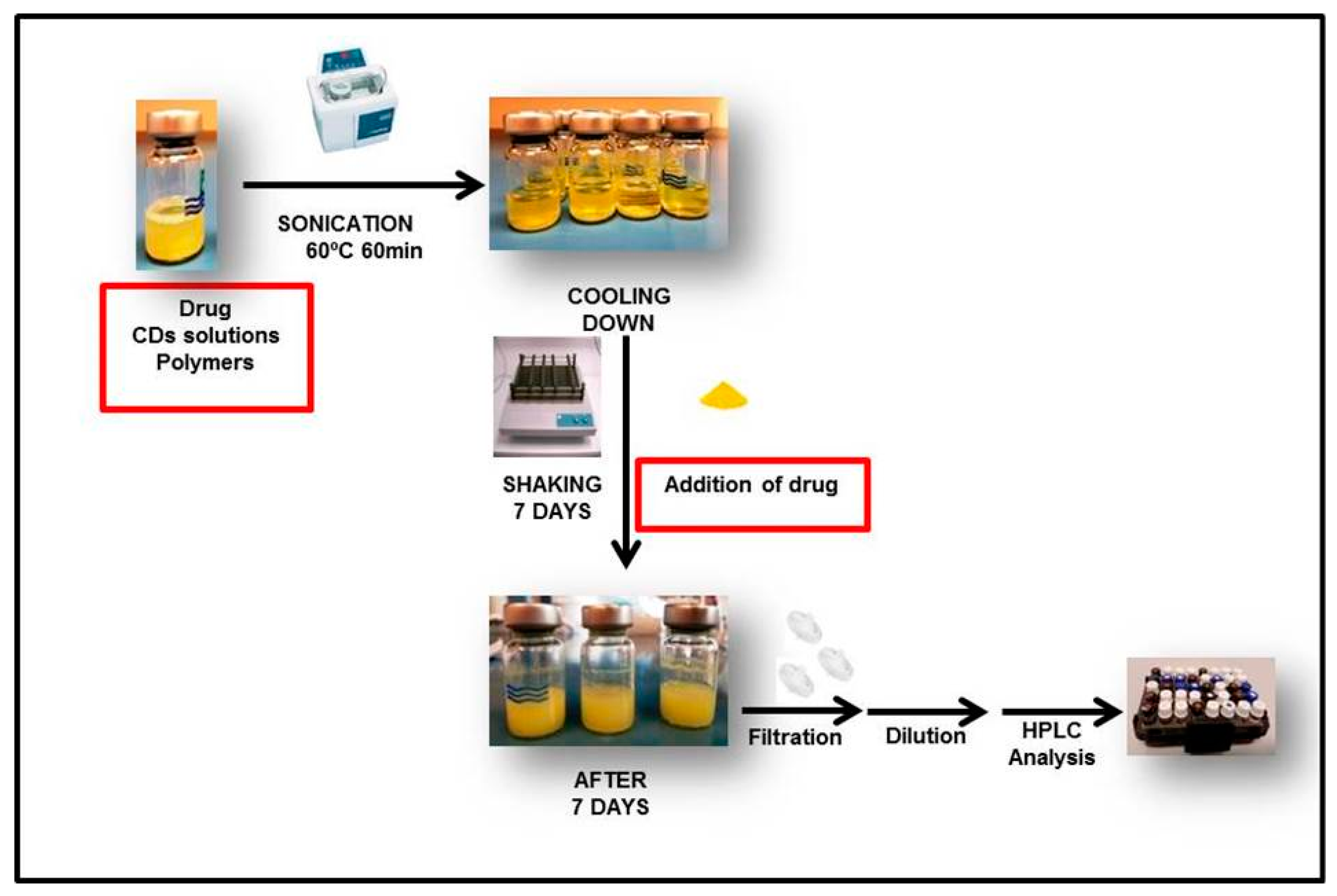
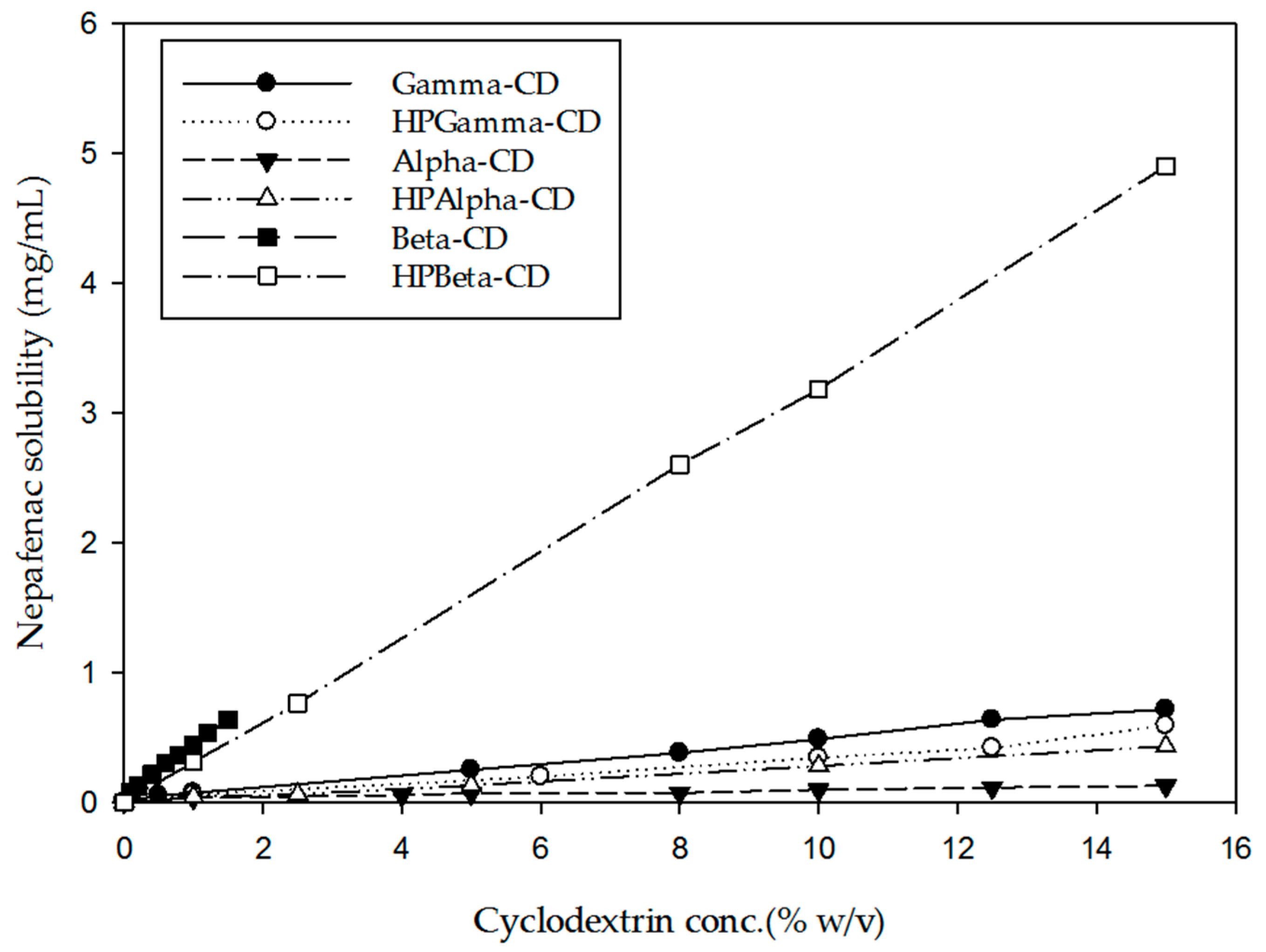
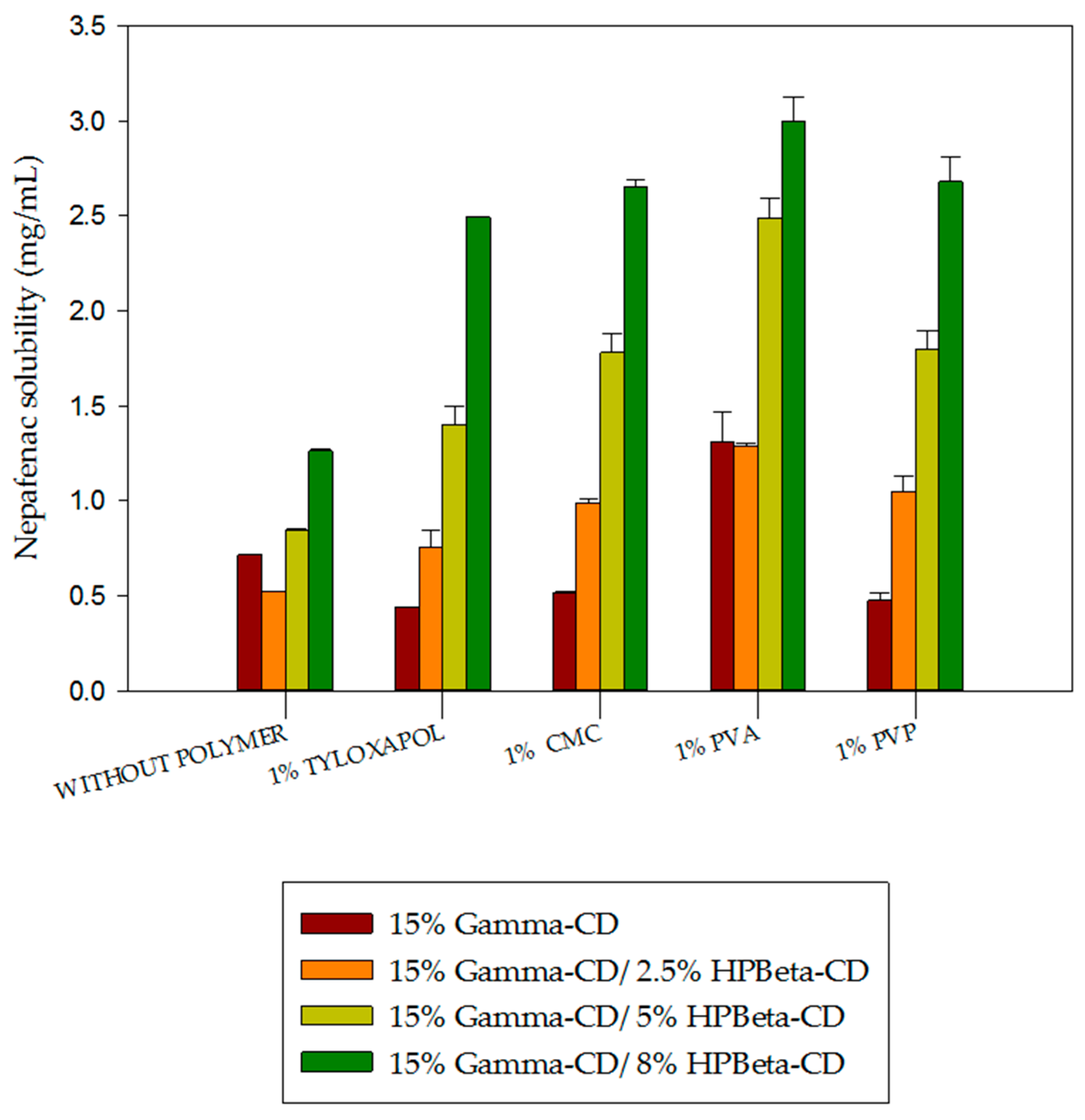
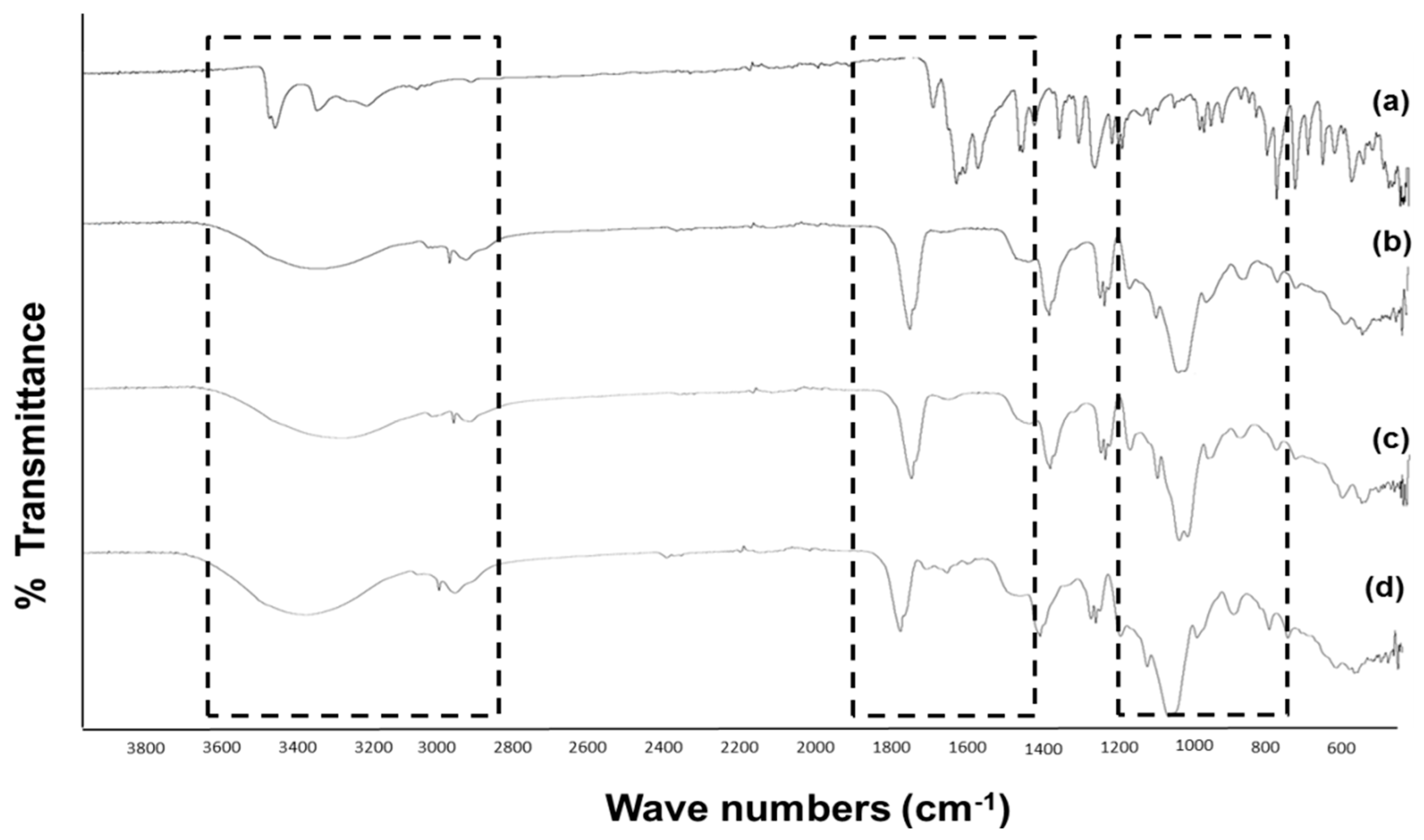


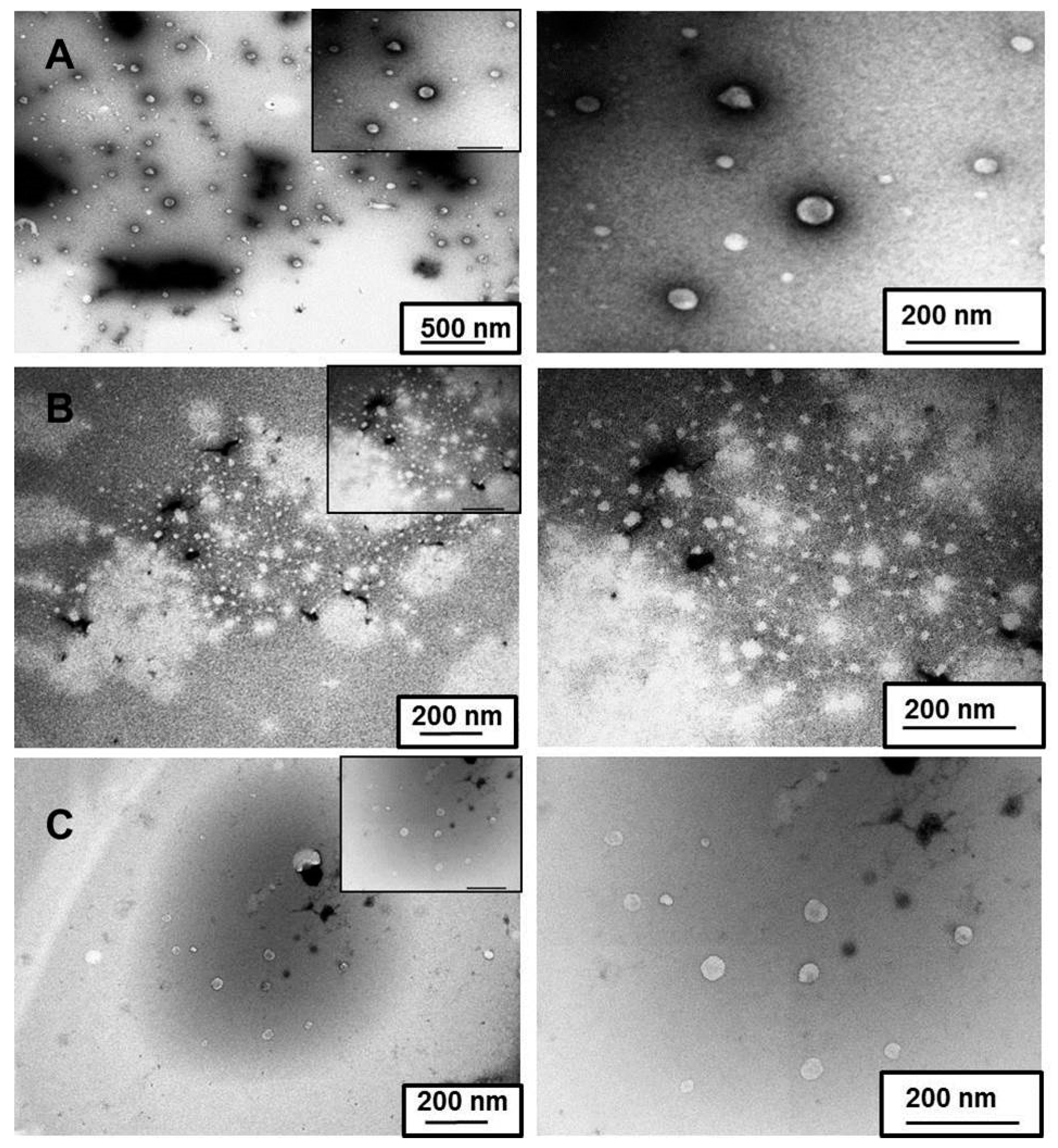
| Formulations | PVP (% w/v) | PVA (% w/v) | CMC (% w/v) | HPMC (% w/v) | MC (% w/v) | Tyloxapol (% w/v) |
|---|---|---|---|---|---|---|
| F1 | - | 2.0 | - | 0.1 | - | 0.1 |
| F2 | - | - | 1.0 | - | - | - |
| F3 | - | 2.0 | 1.0 | - | - | 0.1 |
| F4 | - | 2.0 | - | - | - | 0.1 |
| F5 | 1.0 | - | 1.0 | 0.1 | - | - |
| F6 | 1.0 | - | - | - | 0.1 | - |
| F7 | - | 2.0 | 1.0 | - | 0.1 | 0.1 |
| F8 | 1.0 | - | - | - | - | 0.1 |
| F9 | - | 2.0 | 1.0 | - | 0.1 | - |
| Sonication | Mean (± SD) Nepafenac Concentration (µg/mL) |
|---|---|
| 60 °C 20 min | 6.41 ± 0.08 |
| 60 °C 40 min | 6.49 ± 0.07 |
| 60 °C 60 min | 6.57 ± 0.08 |
| Cyclodextrin | Type | Slope | Corr. | K1:1 (M−1) | CE | Solubility (mg/mL) in the Presence of 15% (w/v) CD |
|---|---|---|---|---|---|---|
| γCD | Al a | 0.024 | 0.998 | 248 | 0.024 | 0.715 |
| HPγCD | Ap a | 0.022 | 0.978 | 218 | 0.021 | 0.590 |
| αCD | Al a | 0.029 | 0.991 | 289 | 0.028 | 0.131 |
| HPαCD | Al a | 0.011 | 0.984 | 113 | 0.011 | 0.401 |
| βCD | Al | 0.180 | 0.998 | 2230 | 0.220 | b |
| HPβCD | Al a | 0.198 | 0.999 | 2515 | 0.247 | 4.460 |
| Protons | γCD | Nepafenac/γCD | Δδ* |
|---|---|---|---|
| H1 | 5.1320 | 5.1554 | +0.0234 |
| H2 | 3.6754 | 3.7031 | +0.0277 |
| H3 | 3.9564 | 3.9782 | +0.0218 |
| H4 | 3.6115 | 3.6339 | +0.0224 |
| H5 | 3.8712 | 3.8925 | +0.0213 |
| H6 | 3.8903 | 3.9146 | +0.0243 |
| Protons | HPβCD | Nepafenac/HPβCD | Δδ* |
|---|---|---|---|
| H1 | 5.1207 | 5.1137 | −0.007 |
| H2 | 3.6686 | 3.6625 | −0.0061 |
| H3 | 4.0386 | 4.0046 | −0.034 |
| H4 | 3.5485 | 3.5468 | −0.0017 |
| H5 | 3.9010 | 3.7681 | −0.1329 |
| H6 | 3.9487 | 3.8912 | −0.0575 |
| –CH3 | 1.1952 | 1.1864 | −0.0088 |
| Formulations | Solubility of Nepafenac (mg/mL) | Solid Drug Fraction (%) | Osmolality (mOsm/kg) | Viscosity (cP) | Size (nm) | |
|---|---|---|---|---|---|---|
| Diameter (nm) | Vol (%) | |||||
| F1 (2% PVA, 0.1 HPMC, 0.1% tyloxapol) | 3.063 ± 0.108 | 61.26 | 198 ± 2 | 3.62 ± 0.03 | 98 | 58.1 |
| 424 | 41.9 | |||||
| F2 (1% CMC) | 2.516 ± 0.014 | 50.32 | 338 ± 13 | 18.92 ± 2.16 | 212 | 55.4 |
| 135 | 28.9 | |||||
| 427 | 13.7 | |||||
| 18 | 2 | |||||
| F3 (2% PVA, 1% CMC, 0.1% tyloxapol) | 3.180 ± 0.066 | 63.60 | 410 ± 10 | 13.95 ± 0.36 | 247 | 88.5 |
| 3.0 | 11.5 | |||||
| F4 (2% PVA, 0.1% tyloxapol) | 3.119 ± 0.010 | 62.38 | 200 ± 2 | 4.17 ± 0.11 | 581 | 29 |
| 241 | 28.8 | |||||
| 1127 | 23.4 | |||||
| 106 | 18.8 | |||||
| F5 (1% PVP, 1% CMC, 0.1% HPMC) | 2.656 ± 0.074 | 53.12 | 400 ± 8 | 15.31 ± 0.88 | 310 | 50.1 |
| 170 | 27.5 | |||||
| 13 | 22.4 | |||||
| F6 (1% PVP, 0.1% MC) | 2.384 ± 0.172 | 47.08 | 186 ± 5 | 4.89 ± 0.31 | 350 | 77.4 |
| 21 | 22.6 | |||||
| F7 (2% PVA, 1% CMC, 0.1% MC, 0.1% tyloxapol) | 2.817 ± 0.015 | 56.34 | 390 ± 4 | 10.15 ± 0.47 | 208 | 89.4 |
| 644 | 9.1 | |||||
| 54 | 1.5 | |||||
| F8 (1% PVP, 0.1% tyloxapol) | 1.685 ± 0.054 | 33.70 | 193 ± 2 | 3.83 ± 0.16 | 17 | 74.5 |
| 781 | 22.5 | |||||
| 1.0 | 3 | |||||
| F9 (2% PVA, 1% CMC, 0.1% MC) | 2.422 ± 0.056 | 48.44 | 392 ± 7 | 13.56 ± 0.92 | 208 | 97.7 |
| 28 | 2.3 | |||||
© 2019 by the authors. Licensee MDPI, Basel, Switzerland. This article is an open access article distributed under the terms and conditions of the Creative Commons Attribution (CC BY) license (http://creativecommons.org/licenses/by/4.0/).
Share and Cite
Lorenzo-Veiga, B.; Sigurdsson, H.H.; Loftsson, T. Nepafenac-Loaded Cyclodextrin/Polymer Nanoaggregates: A New Approach to Eye Drop Formulation. Materials 2019, 12, 229. https://doi.org/10.3390/ma12020229
Lorenzo-Veiga B, Sigurdsson HH, Loftsson T. Nepafenac-Loaded Cyclodextrin/Polymer Nanoaggregates: A New Approach to Eye Drop Formulation. Materials. 2019; 12(2):229. https://doi.org/10.3390/ma12020229
Chicago/Turabian StyleLorenzo-Veiga, Blanca, Hakon Hrafn Sigurdsson, and Thorsteinn Loftsson. 2019. "Nepafenac-Loaded Cyclodextrin/Polymer Nanoaggregates: A New Approach to Eye Drop Formulation" Materials 12, no. 2: 229. https://doi.org/10.3390/ma12020229
APA StyleLorenzo-Veiga, B., Sigurdsson, H. H., & Loftsson, T. (2019). Nepafenac-Loaded Cyclodextrin/Polymer Nanoaggregates: A New Approach to Eye Drop Formulation. Materials, 12(2), 229. https://doi.org/10.3390/ma12020229





